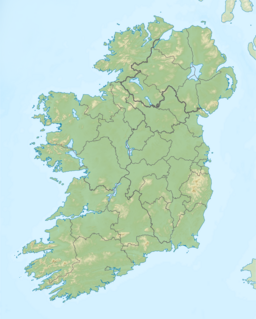| Belhavel Lough | |
|---|---|
| Claonloch (Irish) | |
 | |
| Location | County Leitrim |
| Coordinates | 54°12′31″N 8°11′1″W / 54.20861°N 8.18361°W |
| Primary outflows | Diffagher River |
| Catchment area | 22.24 km2 (8.6 sq mi) |
| Basin countries | Ireland |
| Surface area | 1.01 km2 (0.39 sq mi) |
| Surface elevation | 60 m (200 ft) |
| References | [1][2] |
Belhavel Lough (Irish: Claonloch, meaning 'crooked lake')[3] is a freshwater lake in the northwest of Ireland. It is located in north County Leitrim near the village of Killarga.
Geography and hydrology
[edit]Belhavel Lough is about 2 kilometres (1.2 mi) south of Killarga and 5 km (3.1 mi) north of Drumkeeran.[1] It covers an area of 1.01 km2 (0.4 sq mi).[2] The lake drains east into the Diffagher River, which eventually reaches Lough Allen.[1]
Ecology
[edit]The water quality was reported to be satisfactory c. 2001 – c. 2003 with a mesotrophic rating,[4][n 1] but had a "poor" ecological status c. 2007 – c. 2009 indicating pollution,[6] though Zebra mussel infestation was not reported.[7] The ecology of Belhavel Lough, and other county waterways, is threatened by curly waterweed, zebra mussel, and freshwater clam invasive species.[8][9]
See also
[edit]References and notes
[edit]Notes
[edit]- ^ Trophic states of "Oligotrophic" and "Mesotrophic" are desirable, but freshwater lakes rated 'Eutrophic' or 'Hypertrophic' indicates pollution.[5]
Primary sources
[edit]- ^ a b c Google (10 August 2015). "Belhavel Lough" (Map). Google Maps. Google. Retrieved 10 August 2015.
- ^ a b Free, Gary; Little, Ruth; Tierney, Deirdre; Donnelly, Karol & Caroni, Rossana (2006). A Reference Based Typology and Ecological Assessment System for Irish Lakes (PDF) (Report). Environmental Protection Agency (Ireland). p. 10. Retrieved 12 October 2022.
- ^ "Claonloch/Belhavel Lough". Placenames Database of Ireland. Government of Ireland - Department of Arts, Heritage and the Gaeltacht and Dublin City University. Retrieved 10 August 2015.
- ^ Clenaghan, Clinton & Crowe 2005, p. 97.
- ^ Clenaghan, Clinton & Crowe 2005, p. 8.
- ^ EPA 2010, pp. 7, 84.
- ^ EPA 2010, p. 80.
- ^ Pedreschi et al. 2014.
- ^ Clenaghan, Clinton & Crowe 2005, p. 16.
Secondary sources
[edit]- Clenaghan, Conor; Clinton, Frank; Crowe, Matthew (2005). Phosphorus Regulations National Implementation Report (PDF) (Report). Environmental Protection Agency, Office of Environmental Enforcement.
- Pedreschi, D.; Kelly-Quinn, M.; Caffrey, J; O'Grady, M.; Mariani, S.; Phillimore, A. (2014). "Genetic structure of pike (Esox lucius) reveals a complex and previously unrecognized colonization history of Ireland". Journal of Biogeography. 41 (3): 548–560. doi:10.1111/jbi.12220. PMC 4238397. PMID 25435649.
- EPA (2010). Martin McGarrigle; John Lucey; Micheál Ó Cinnéide (eds.). Water Quality in Ireland 2007-2009 (PDF) (Report). EPA, Aquatic Environment Office of Environmental Assessment.

Well, that’s interesting to know that Psilotum nudum are known as whisk ferns. Psilotum nudum is the commoner species of the two. While the P. flaccidum is a rare species and is found in the tropical islands. Both the species are usually epiphytic in habit and grow upon tree ferns. These species may also be terrestrial and grow in humus or in the crevices of the rocks.
View the detailed Guide of Psilotum nudum: Detailed Study Of Psilotum Nudum (Whisk Fern), Classification, Anatomy, Reproduction